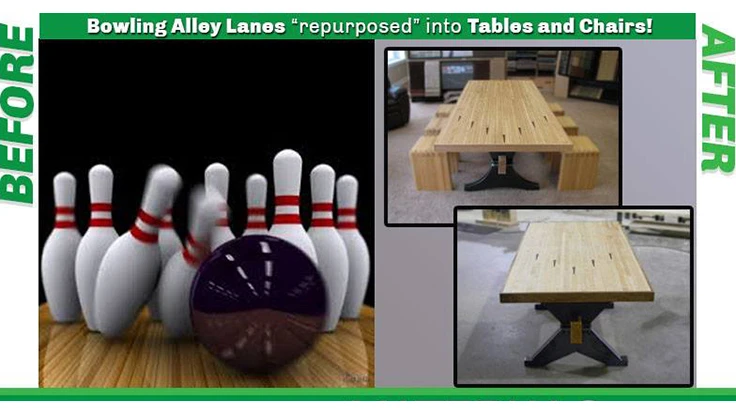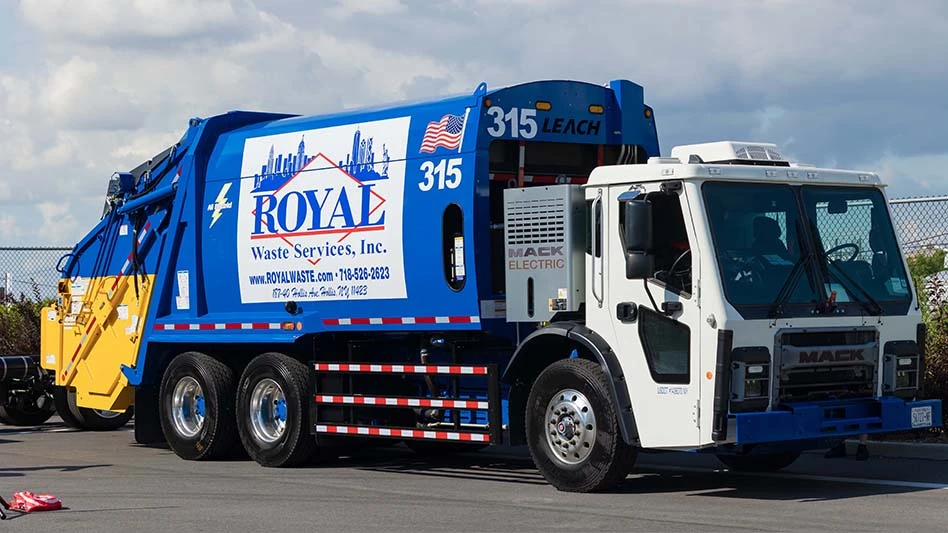
Ladies and gentlemen, boys and girls, today we’re going to do a sustainable materials management magic show. Yes, a little hocus pocus. We’re going to take an industrial waste stream and turn it into something completely different. Prepare to be amazed!
Let’s start with a 10-foot tall tire off the huge mining dump trucks that haul copper in Arizona, gold in Nevada and coal in Wyoming. These can be major disposal headaches for these mining companies when all the tread is worn off.
Hocus Pocus. You slice the tire in half like a bagel, place it out in a cow pasture, fill the center hole with concrete and you have a water tank for cattle that will last 75 to 100 years.
Next up is old basketball gym flooring. These are tongue-and-groove maple boards nailed to a plywood substrate. Over the course of 20 to 30 years, these floors are re-sanded and re-finished multiple times. But, eventually they must be replaced.
Hocus Pocus. You pry the maple off the plywood, grind off the nails and then re-install the boards as a “feature wall” in a restaurant or events center. All colors from the three-point lines, the free throw line, and the out-of-bounds lines are now randomly dispersed on the wall for a fun, whimsical design. (Basketball great Michael Jordan’s restaurant company is one of our customers.)
Last up are old street sweeper brushes. These are the cylindrical 60-inch wide brushes that flick the dirt off the streets in front of your house. It is an 8-inch steel pipe with plastic bristles sticking out in every direction. They start out about 36 inches in diameter and when they get down to 22 to 24 inches, they are too small to be effective.
Hocus Pocus. These street department castoffs are installed in the pens of zoos across America. They become backscratchers for elephants, water buffalo, giraffes and rhinos. Cattle ranchers, dairy farmers and horse owners also place them in their pastures to keep the animals from tearing up fencing as they incessantly scratch. (The Bronx Zoo in New York City is one of our customers.)
THE (GRAND) MOTHER OF INVENTION
So, you might be thinking these are cool ideas, but I’m not the creative or innovate type. Wrong!
Let’s go back to when you, or one of your kids, was in preschool. Remember the cylindrical Quaker Oats oatmeal canister? It almost never went right into the trash or recycling after the oatmeal was gone. You probably made a drum or flower vase or school supply storage container out it. That is “repurposing.” The huge Maytag refrigerator box. Did that ever go right to the trash or recycling? Of course not, you extended its life by making it a fort, a playhouse, or a spaceship. So, you can see this “repurposing” gene is really innate.
The key is being resourceful. Most kids are resourceful by nature. Give them the cardboard toilet paper rolls or some old pots and pans and they’ll figure something out.
Most adults, by contrast, have no need to be resourceful. Unfortunately, abundance is the enemy of resourcefulness. Twenty-first century America is a land of abundance. Resourcefulness isn’t necessary. Remember your parents or grandparents who lived through the Great Depression? The Greatest Generation was resourceful because they had to be. An old pair of women’s nylons never went straight to the garbage. There were hundreds of ways to repurpose panty hose, and people did. They did it because they didn’t have a choice.
Repurposing really isn’t that outside the box if you stop and ponder for a moment. There are a number of mainstream repurposes that you’re likely very familiar with that you aren’t even thinking about. Old oak wine barrels get sliced in half and made into flower planters. Used car and truck tires get hung on the sides of tug boats and docks as fenders or bumpers. Big 40-foot shipping containers get windows and doors installed and they become tiny houses.
Retired vinyl advertising billboard like you see along the highway promoting Geico insurance, Pepsi or Chevrolet can get a second life as waterproof tarps, pond liners and water slides for kids. Dismantled aluminum stadium planks get an extended life as decking on boat docks and cargo trailers. End-of-life military parachutes that are up to 100 feet in diameter become shade canopies at events and backyard weddings.
TROUBLESHOOTING AND TRIAGE
OK, these are all great ideas but how do you know if a waste stream can be repurposed? To help determine if a product is a candidate for repurposing, following is a formula to help you identify repurposing candidates. The matrix is coincidentally called “S.A.V.E. It.” The more positive answers to these four themes, below, the greater the odds are for extending a material’s life.
- Standardized – The more standardized a waste stream, the more possibilities for repurposing. A random pile of dimensional lumber with lengths from ranging from 23 to 87 inches is much harder to find a repurposing niche for than if all the scrap lumber is exactly the same size and length.
- Available – Is the waste stream recurring or is it a one-time waste stream? To be recurring, it can be recurring at an individual organization or at the broader industry level. For example, a specific fire department may only change out fire hoses every five years, but somewhere in America there is probably a department changing out hoses almost every week.
- Versatility – We actually use three words here: generic, versatile and adaptable. Things that are really specialized will likely never be repurposed.
- Engineering – Again, we use three words here: attributes, characteristics and engineering. What unique things are inherent in the product or material that might be a solution to some other problem? Is it magnetic, hollow, waterproof, UV-resistant, light, buoyant, etc.? If yes, look for other industries that are looking for those specific qualities.
However, just because something is a good candidate for “repurposing” doesn’t mean it will be commercially viable. The fabric from hot air balloons meets all the criteria above. They have standardized sizes, they regularly get retired, the textile is very versatile, and the colors and patterns are very intriguing attributes, but they’ll never become commercially successful. Know why? Because at end of life, the fabric absolutely reeks. Receiving fumes from the propane, the fabric is never allowed to completely dry between flights, combining to make end-of-life balloons smell most unpleasant.
Or, how about the inflatable evacuation slides off jetliners? The Federal Aviation Administration (FAA) mandates they get replaced every 48 months. An old inflatable slide would make a great party barge behind a speedboat at an inland lake. A zookeeper, by contrast, looks on old slides as a big inflatable pillow, or fall pad, to be used to protect elephants or hippos when they fall over after being tranquilized them for medical procedures. You guessed it, though, these will never be commercially repurposed. Know why? Because the FAA rules are that these slides must be shredded after they are removed from the aircraft.
Do not be discouraged by these negative examples, however. The success stories are more numerous. You can find examples of successfully repurposed materials on this Web page.
Ladies and gentlemen, boys and girls, that completes our whirlwind trip through the creative and innovative process of finding alternative second lives, or repurposes, for industrial castoffs on the road to Sustainable Materials Management.
Latest from Waste Today
- US Senate backs reduced cuts to EPA
- Waste Connections announces Q2 results
- Returnity and Cosmoprof to address reusable bag waste
- SWANA releases report on aging WTE facilities
- New economic assessment reveals cost benefits of California’s SB 54
- Premier Truck Sales & Rental opens new facility
- TeknTrash Robotics, Sharp Group partner on humanoid robot pilot
- Stadler equips mixed waste sorting plant in Sweden





